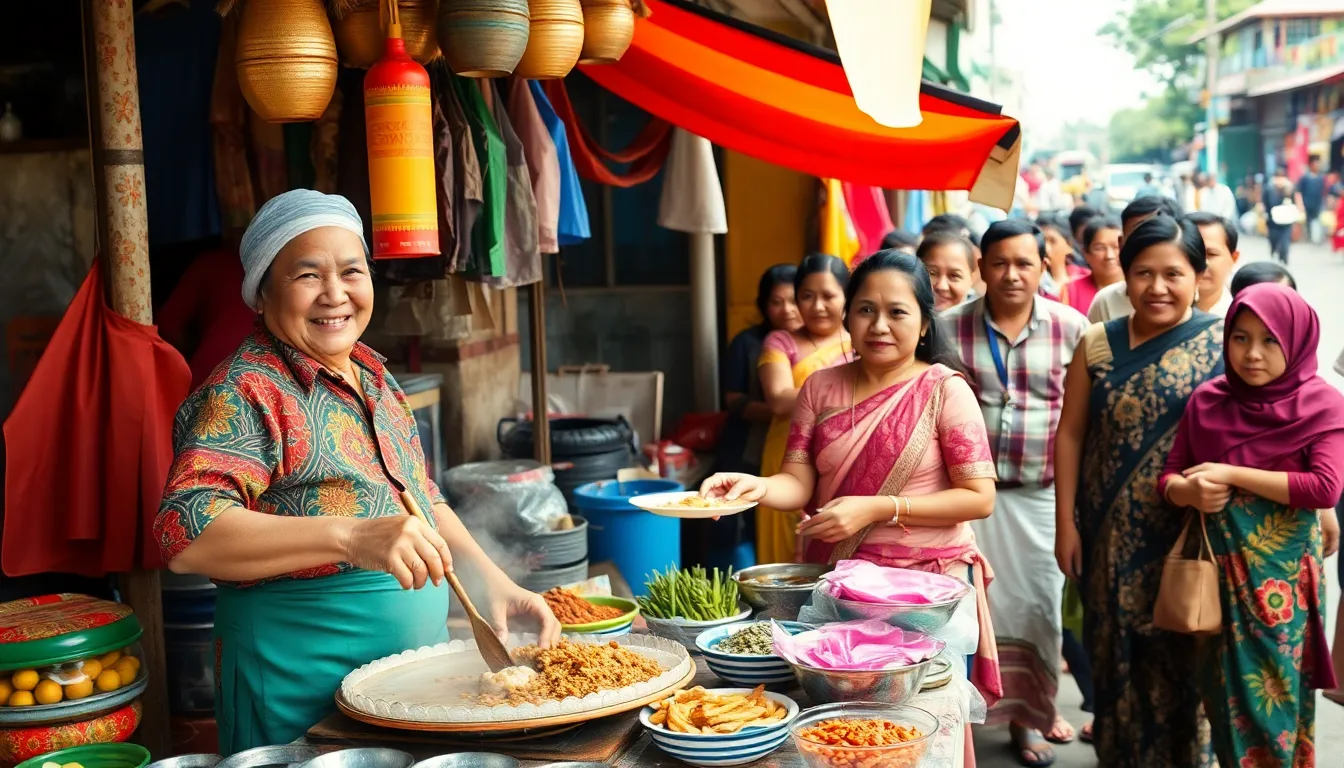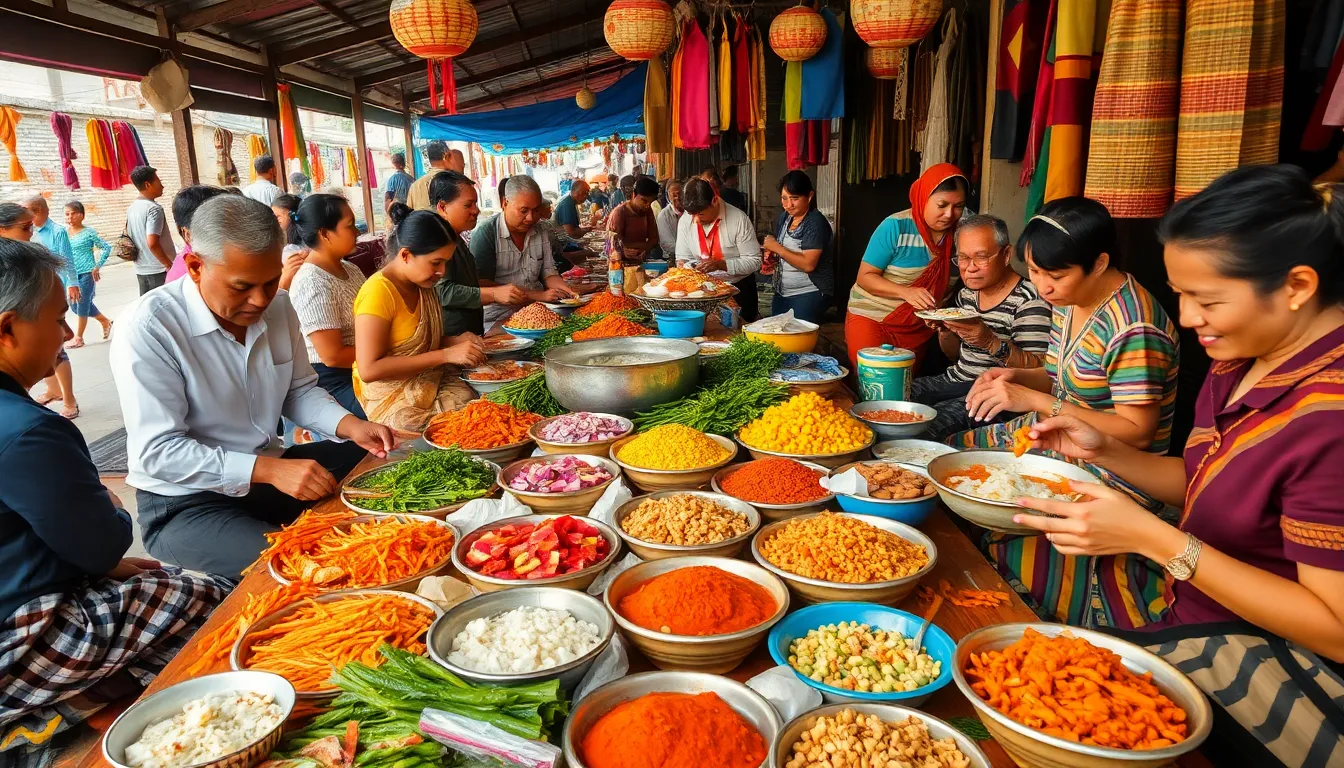Table of Contents
ToggleIn the vibrant tapestry of Myanmar’s culinary scene, hingagyi stands out as a delightful gem that’s just waiting to be discovered. Imagine a dish that’s not just food but a celebration of flavors, textures, and a dash of local charm. This isn’t your average meal; it’s a culinary adventure that’s sure to tickle your taste buds and leave you craving more.
Overview of Hingagyi
Hingagyi stands out in Myanmar’s diverse cuisine as a delightful dish featuring rice and various toppings. Often compared to savory rice dishes found in other cultures, this dish consists of boiled rice served with a mix of ingredients. Popular toppings include fried onion, shredded chicken, boiled egg, and a flavorful sauce that enhances the overall taste.
Local variations contribute to its uniqueness, with each region in Myanmar showcasing distinct ingredients and preparation methods. In some areas, vendors offer hingagyi with added vegetables, providing a nutritious boost. It pairs well with fresh herbs like cilantro or mint, which elevate the dish’s refreshing flavor profile.
Hingagyi is not just a meal; it’s often enjoyed during social gatherings and celebrations. Street vendors across Myanmar provide easy access to this dish, making it a staple for both locals and tourists alike. The aroma of hingagyi wafts through the streets, enticing passersby to indulge in its savory goodness.
People appreciate hingagyi for its balance of flavors and textures. Its combination of soft rice, crunchy toppings, and zesty sauce creates a satisfying culinary experience. As a result, this dish has garnered affection from many, becoming a beloved component of Myanmar’s gastronomic identity.
Hingagyi exemplifies the rich culinary traditions of Myanmar, offering a taste of the country’s vibrant culture. Food enthusiasts and adventurers alike explore this dish, adding it to their must-try list when visiting Myanmar.
History of Hingagyi in Myanmar


Hingagyi boasts a rich history deeply rooted in Myanmar’s culinary traditions. This beloved dish reflects cultural influences that span generations.
Cultural Significance
Traditionally, hingagyi symbolizes hospitality and community. Sharing this dish during family gatherings and special occasions strengthens bonds among individuals. Street vendors often prepare it, making it accessible to all. Vendors showcase local variation, incorporating regional ingredients to enhance its flavor. Celebrations typically see hingagyi served alongside other dishes, underscoring its role in festive meals. The dish transcends mere sustenance; it represents connection through flavor, bringing friends and family together in Myanmar.
Regional Variations
Hingagyi exhibits notable regional variations across Myanmar. In the Mandalay region, locals often add unique spices, enhancing the dish’s flavor profile. Coastal areas may feature seafood toppings, providing a distinct taste. Shan State showcases fresh herbs and vegetables, appealing to health-conscious diners. Additionally, variations arise during certain festivities, where special ingredients change the usual offerings. Street vendors adapt recipes, ensuring each version resonates with local palates. Such regional differences highlight the complexity and richness of hingagyi within Myanmar’s diverse culinary landscape.
Ingredients Used in Hingagyi
Hingagyi features a combination of ingredients that enhance its flavor and texture. This unique dish showcases a variety of elements that contribute to its taste.
Primary Ingredients
Boiled rice serves as the base for hingagyi. Fried onions provide a crispy texture, adding a savory depth to every bite. Shredded chicken contributes protein, enriching the dish with flavor. A boiled egg adds creaminess and additional nutrition. Each of these primary components creates a harmonious balance that defines hingagyi.
Unique Additives
Local variations introduce unique additives that elevate the dish further. Spices prevalent in Mandalay, such as chili powder, impart a spicy kick. Coastal regions may include seafood toppings, enhancing flavor with freshness. Fresh herbs from Shan State, like cilantro and mint, add brightness and complexity. These distinct regional ingredients reflect the diversity of Myanmar’s culinary scene, making each serving of hingagyi a unique experience.
Preparation Methods
Hingagyi showcases a variety of preparation methods, merging tradition with innovation to highlight its regional diversity.
Traditional Cooking Techniques
Traditionally, hingagyi involves cooking rice using steam or boiling methods. Soft, fluffy rice serves as the dish’s foundation. Fried onions are prepared separately, adding texture and flavor. Shredded chicken is typically boiled and seasoned with local spices, enhancing its taste. Boiled eggs are often sliced and placed atop the rice. Finally, a zesty sauce made from local ingredients complements the dish, with each region contributing its unique twist.
Modern Adaptations
Modern adaptations of hingagyi embrace contemporary cooking methods while preserving its essence. Some chefs opt for a rice cooker to achieve perfectly cooked rice consistently. Grill or sauté techniques introduce new flavors to the toppings, such as smoky chicken or spicy sautéed vegetables. Innovative sauces, including fusion ingredients, are now common, appealing to a broader audience. Local restaurants frequently feature gourmet versions, elevating this traditional dish while maintaining its comforting roots.
Serving Suggestions
Hingagyi offers versatility in pairing and occasions. Its delightful flavor profile allows it to complement various dishes seamlessly.
Pairing with Other Dishes
Serving hingagyi alongside other popular dishes enhances the overall dining experience. Flavors from curries, such as chicken or fish curry, blend beautifully with the rice base. Fresh vegetable salads provide a crisp contrast to the rich toppings. Adding a side of fermented fish paste adds a layer of complexity and tradition. Diners appreciate the harmony created by mixing textures and flavors when enjoying hingagyi with these accompaniments.
Popular Occasions for Serving
Hingagyi shines during significant social gatherings in Myanmar. Festivals and family celebrations commonly include this dish as a cherished staple. Street vendors often serve hingagyi at local fairs, attracting both locals and tourists. Class reunions and traditional ceremonies also see hingagyi featured prominently, symbolizing unity and hospitality. Its availability makes it a go-to option during communal meals, fostering connection and sharing among attendees.




